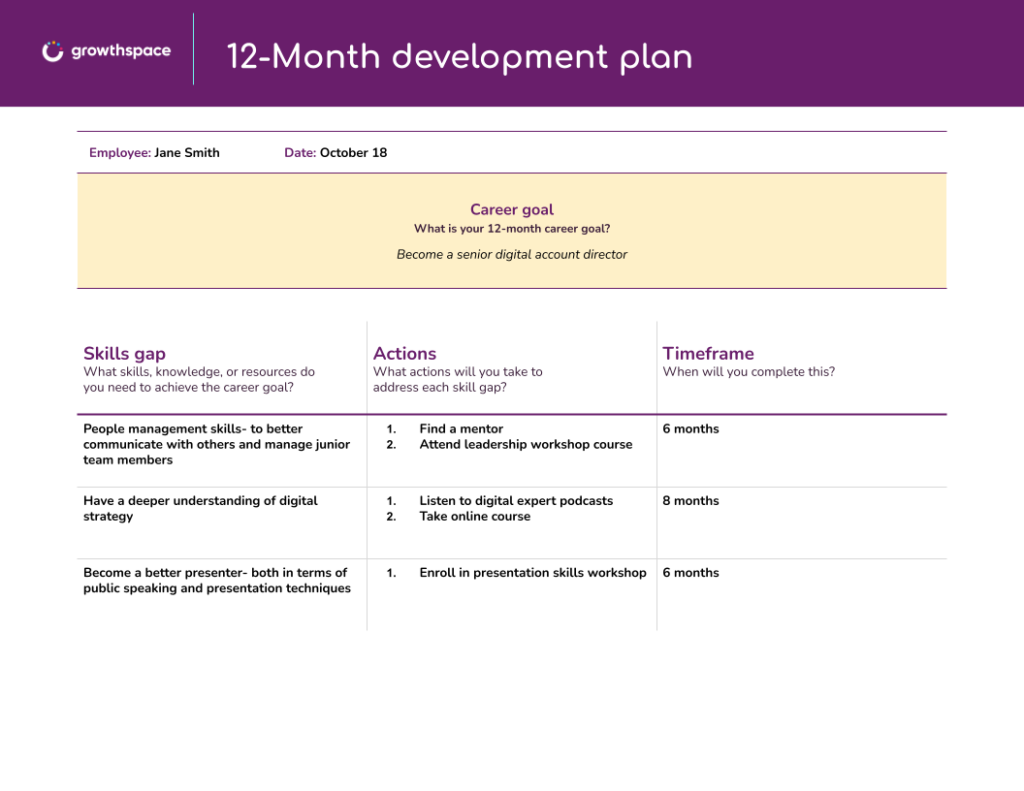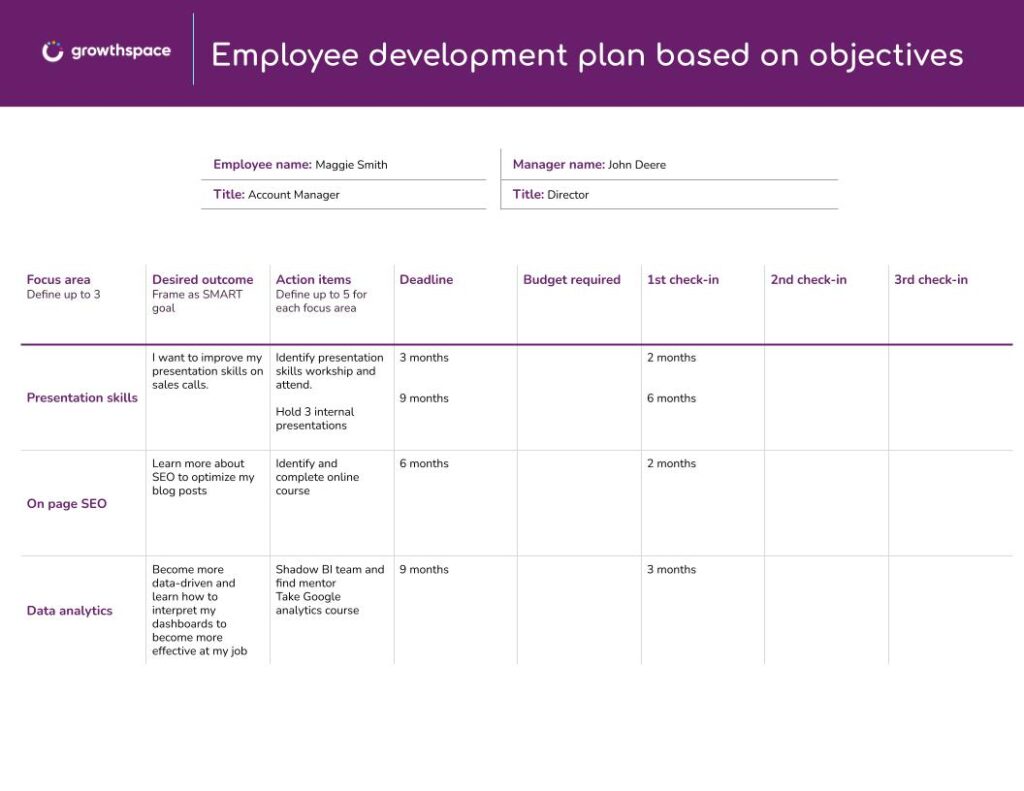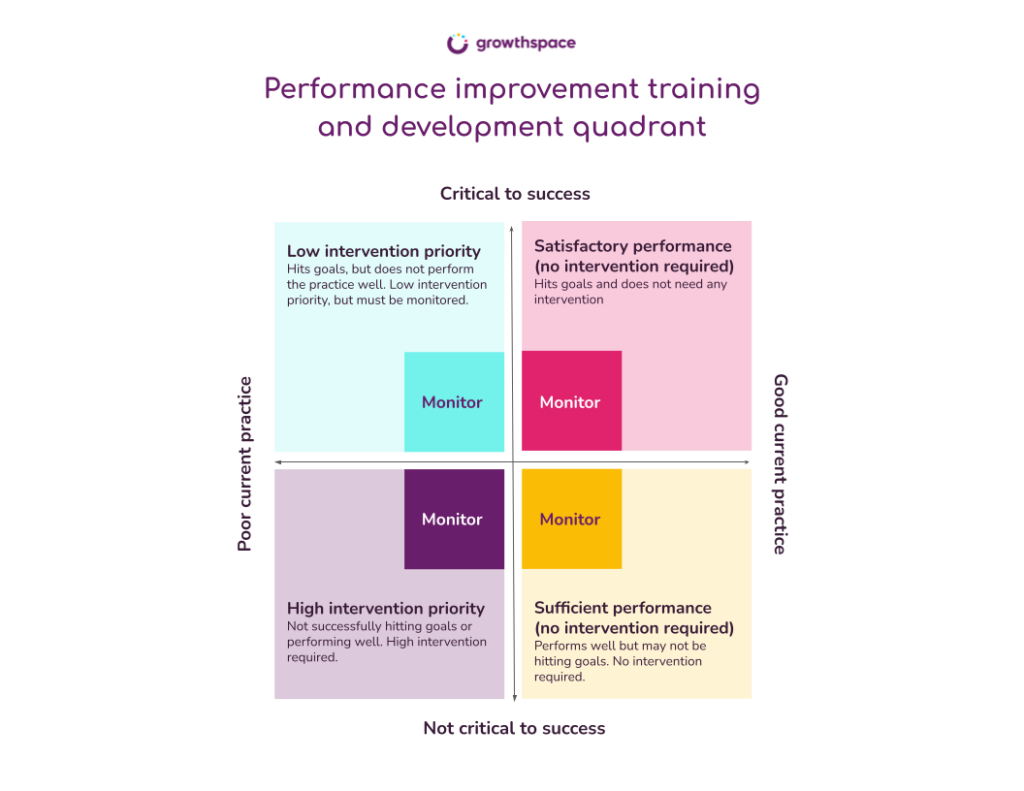Employee development plans are essential for demonstrating that companies care about career progression. That’s why, if employee retention is one of your priorities, having an employee development plan in place is simply a must. It creates a formal pathway for improving an employee’s knowledge, performance, and skills at work.
But then there are effective employee growth plans. Unfortunately, many companies struggle with providing training and development that matches the exact needs of individual employees. The reasons for this include difficulties with:
- Sourcing experts (coaches, mentors, and trainers) with specialties in granular skill areas
- Coordinating employee development programs across potentially hundreds of workers and dozens of experts
- Enabling measurable employee development goals to understand the progress of the worker, the quality of training programs, and effectiveness of experts
The L&D industry is full of authorities, philosophies, and methods that promise success, but often fail to meet their mark. In turn, employees are frustrated by the scarcity or unfulfilled promises of employee development plans that are meant to advance their careers and make them successful. Survey after survey in recent years has made this clear, as employees cite the “lack of growth opportunities/career development” as a top reason for leaving their jobs.
What Is a Personalized Employee Development Plan?
The answer to this problem is to create development plans that are centered around individualized courses. Simply put, a personalized employee development plan covers:
- Precise skills that the employee wants and that the organization needs
- A schedule of experts and courses to provide the skills
- An evaluation method based on measurable goals
Employee development plans are linked to individual workers, so it follows that HR should use a template that allows entries for specific employees. Furthermore, because training occurs over time, the record should be set up for numerous entries.
Employee Development Plan Goals and Benefits
Arranging these programs can be complicated. But the results and benefits of an effective development planning process are highly significant:
- Expanding Width and Breadth of Skills
Companies that are increasing in size or entering new markets usually need a bigger skills inventory. Personalized employee development plans can have many related goals. Examples include building leadership skills, nurturing self-management abilities, and improving critical thinking approaches. Common employee development plan examples include general soft skills training, exposure to leadership roles, and succession planning.
- Taking Proactive Steps
The purpose of an employee development plan is to help an organization’s growth, development, and productivity. Having a plan in place will enable proactive skills-building (rather than taking a reactive approach), which can result in higher productivity and job satisfaction.
- Increasing Your Organizational Flexibility
When you have a plan set up, it makes it much easier to shift priorities and move development sprints around, since you already know what your goals are. Without a ready plan, even the smallest pebble can get caught in your cogs and create even more chaos.
- Creating a Culture of Learning Across Your Organization
With buy-in from upper management and support throughout the organization, employee development can foster a new culture of learning that keeps employees excited and helps to attract new talent who understand the value of continued development. In fact, according to Deloitte, companies with a learning culture:
- Are 92% more likely to innovate
- Show 37% greater employee productivity
- Are 58% more prepared to meet future demand
- Improving Performance AND Output
An effective employee development plan enables employees to improve relevant professional skills or learn new, faster ways to do work that previously took long periods of time. Considering that employee engagement levels today are at 31%, which is a ten-year low, an employee development plan and the L&D backup that goes along with it can greatly increase productivity. At the same time, it makes employees feel valued as they contribute more to the organization – especially important due to remote and hybrid ways of working.
- Retaining Current Employees
The expense to replace a single employee can cost anywhere from 50% to 200% of the worker’s annual salary, depending on the employee’s seniority and the company’s method of recruiting. Employee development plans, along with an effective L&D strategy, reduce the likelihood of employee churn.
- Growing Potential Talents into Leaders
Recent years have seen significant job cuts in certain industries. Currently, in the US, layoffs are at a rate that is almost 50% higher than this time last year. Among those employees who have been let go are doubtlessly thousands of managers. They have left behind teams that are struggling to make do without leaders and their knowledge. An effective employee development plan mitigates this issue by having succession plans already in place. Development programs in these situations can be created quickly, especially if the organization is already using an L&D platform.
How Do Other Kinds of Development Plans Fit?
In the HR “toolbox”, there are many types of development that fit various sorts of objectives. Let’s examine three common types of development plans and how they differ:
- Employee development plans cover all the activities that an employee does, with the support of HR, to grow in their current role and prepare for future ones. This can include acquiring soft skills, training in areas that are specific to the company, onboarding, and experiential training like job rotation.
- Professional development plans focus on the skills that a worker will use throughout their career. There are many such abilities, but some common areas for professional development include communications, leadership, and problem-solving.
- Career development plans go one step beyond professional development plans to discuss certain roles that an employee might take at their current organization. Career development plans include the same types of training as employee development plans, but add the long-term focus of a professional development plan.
Examples of Employee Development Plans
The structure of employee development plans can be as diverse as employees themselves. Some put all the focus on the employee’s skill gaps, while some include equal responsibility for the employee’s manager; some list goals and tasks disparately, while others connect each goal to particular action items, and so on. Choosing the right style of plan depends on the employee’s role, experience, objectives, timeline, and other factors. To give you an idea, here are three sample formats of commonly used employee development plans:
Employee Development Plan Based on Time Frame
This style of employee development plan breaks down training needs and milestones according to exact time periods.
<< Download FREE 12-Month Employee Development Plan Template >>
Employee Development Plan Based on Objectives
Some find it most helpful to structure the employee development plan according to professional areas and outcomes, including the action items and costs involved.
<< Download FREE Development Plan Based on Objectives Template >>
Employee Development Plan Based on Performance
A more aesthetic way to present an employee development plan is to put the focus on overall performance, looking at the big picture, as opposed to detailing certain skills.
FREE Employee Development Plan Template >>
Steps for Creating an Employee Development Plan
1. Analyze Skills and Set Goals
The first step in creating an employee development plan is to conduct a skill gap analysis:
- Examine current levels: Determine what types of skills are lacking among the current staff, and remember to ask employees about which skills they believe are important to develop for both themselves and the company.
- Account for strategy: Check if strategic plans might require new skills to be developed.
- Look at industry trends: See if there are new kinds of development initiatives that may be relevant to your organization and employees.
- Put it all together: Organize the employees, experts, materials, and schedule for the employee development plan.
- Set goals: Set evaluation points, including KPIs, for metrics like course completion rates and manager approval, to determine if the employee development plan was successful. This is crucial for understanding if your employees are gaining the expertise and knowledge needed for their careers.
Determining the skills gap and goal-setting for individual employees can be a complex exercise. For example, if you wanted to create an employee development plan for sales management skills, it would involve multiple activities. The employees would receive instructions about improving their own sales abilities, managing others, and using departmental systems.
But each of these skills requires a separate goal or KPI. In addition, the above example shows how “sales management” is a group of elements, each of which needs dedicated instruction. The employee development plan must be adjusted for such individual requirements; otherwise, employees will potentially waste their time and energy on irrelevant material.
Finally, chances are that an experienced employee requires less advising than a new one, so any employee development plan must account for seniority as well. In short, an effective employee development plan must be scalable and able to adjust to the needs of individuals.
2. Run Courses, Source Experts, and Recruit Managers
Your next step is to arrange learning and development courses for upskilling and to close organizational skill gaps. Some companies have internal experts for this purpose. But many contract with external companies and individual instructors because the best ones have:
- An extensive history in teaching professional subjects
- Knowledge of the latest instructional techniques
- A list of previous engagements
- Well-founded opinions on how to teach the subjects that you are considering
The current approach to finding experts usually relies on an organization’s “go-to” list, or finding local coaches and trainers who have a background in a certain skill set, such as “management” or “communication”. Yet one of the reasons behind failed employee development plans can be traced to the “elements” problem discussed above: certain skills should be taught on a granular level.
For example, communication encompasses skills that include writing, presentations, and speaking. Plus, there are particular talents that teach speaking as a teacher would, in comparison to a CEO delivering a motivational speech.
Locating the right qualified experts for your employees’ specific skill gaps is critical in developing effective employee development plans. Each employee should receive instruction from an expert in the specific skill that they require. If “managing sales employees” is the targeted skill, then the expert should address this exact area.
It may be necessary for an organization to leave their comfort zone and find different types of specific experts. This move is highly practical in today’s market, where required skills frequently change. And today, with online platforms that connect organizations to qualified, highly-vetted experts, companies can more easily find the relevant coach, expert, or trainer to help fill a specific employee’s gaps.
Another essential part of any employee development plan is the employee’s manager, who needs to:
- Participate in scheduling the course, if required by HR
- Arrange the employee’s tasks so productivity is not affected
- Provide feedback and evaluation (in the next phase)
- Get employee development plan buy-in from senior management to ensure successful employees have the backing of the C-Suite
This last point is often overlooked. There isn’t much reason for an employee to work hard in a development program but see no upside, and yet this situation is common today. The “Great Stay” phenomenon, in total contrast to the “Great Resignation”, connects to low engagement rates as workers don’t feel confident about finding jobs more to their liking. It should be understood within the organization that an employee who passes employee development plans should either be promoted, given a raise, or receive another kind of recognition for their efforts.
3. Evaluate the Employee, Course, and Expert
The most common practice is to conduct a feedback session halfway through the employee development plan, and then again at the end. The challenge here is to use an evaluation method that makes sense to all of the stakeholders. As an example, perhaps the HR department can understand the wide variety of evaluation methods that are out there, but not the sales department manager.
That’s why a simple approach that concentrates on the end result – improved performance – is optimal. Additionally, if the organization wants to use the same expert and method of instruction in the future, then the same sort of question should be asked – did the course and the expert enable the employee to reach the employee development plan’s goal?
An Essential Best Practice for Employee Development Plans
Employee development plans are a balance between what the organization needs and what the employee wants to do. It’s a mistake to look at a skills gap analysis and assign upskilling activities to workers who have related roles. Instead, you need to find the best employee for the plan at hand. Outlined below are useful steps to ensure that everyone is on the same page. Make sure that you discuss these topics when meeting with employees about their individual plan.
Be Honest About Goals
You might start your conversation about realistic goals by asking an employee what position they expect to reach within the next five years or so. Make sure to cover the pros and cons of their choice as well as how their personal goals and values fit.
Not everyone is meant to be a CEO. This is obviously because most companies are pyramid-shaped, but it’s also true that not every person has the motivation or abilities to reach the top. Work-life balance in particular is a factor that often limits people from investing all of the effort necessary for executive positions.
Time is another consideration. Organizations that hire top managers from within might promote you to the executive staff only after years of hard work. There is also usually more than one contender for the highest levels of leadership. There is no guarantee that the ambitious employee sitting in front of you will ultimately be chosen, because great companies often have lots of talented and motivated workers.
Check In Regularly
Employee development plans are meant to last for months, or even years, and so HR’s commitment to supporting them should also extend for that time. By interviewing an employee about progress towards their original goals, you can:
- Discover if the worker is still interested in their current path or shows a desire to revise it
- Get feedback about their experience to date and what they would wish to change as a way of increasing their motivation
- Act as an accountability partner
- Find out if the plan itself is properly designed and has given them the proper skills for advancement
Take the Easier Path with Growthspace
The Growthspace precision skill development platform offers organizations the easy way to create and deliver effective employee development plans. The Growthspace journey begins by identifying skill gaps down to a granular level through a proprietary taxonomy. Then, the system matches each skill with the right expert who provides training through sprint-based courses.
In this way, Growthspace rapidly reduces employee skill gaps and creates a culture of learning and development that will not only retain your employees, but also keep them engaged. The Growthspace platform even enables evaluation and administrative functions that are accessible to all stakeholders with its user-friendly interface.







